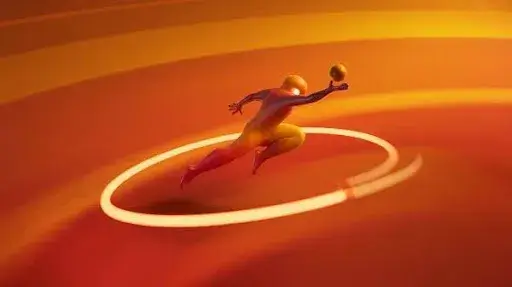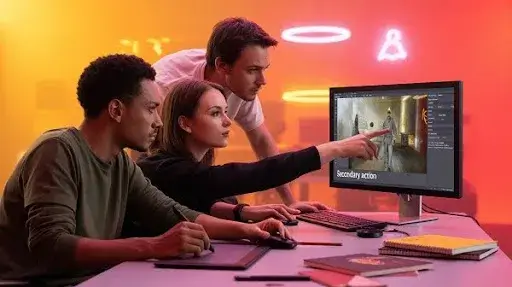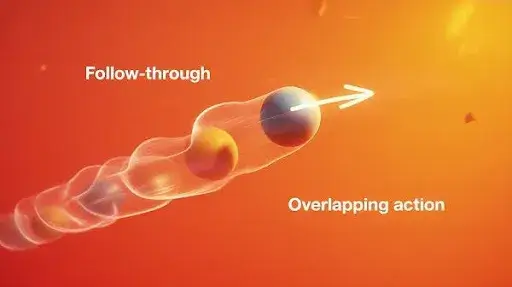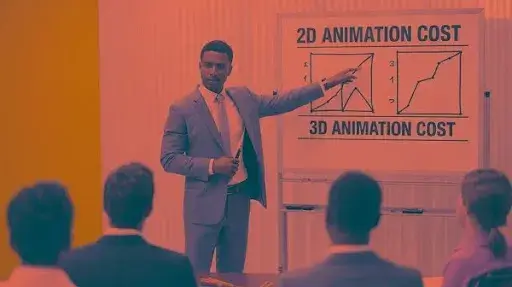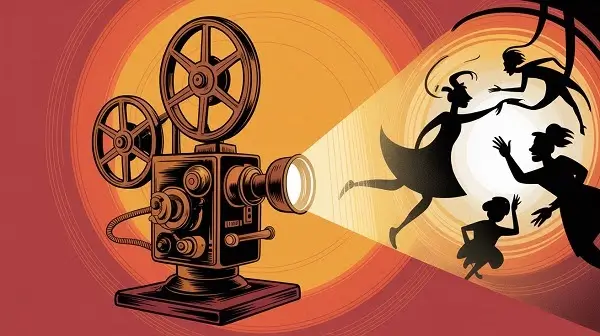Animation is never about motion alone. It’s about motion that feels alive, movement that convinces you a drawing, a puppet, or a 3D model has weight, breath, and a mind of its own. That spark of believability doesn’t happen by accident.
It comes from a careful balance of the 12 principles of animation, and among them, one principle tends to get underestimated: secondary action in animation.
Ask any 3D animation experts or veteran character animator, and they’ll tell you, secondary action isn’t just an add-on. It’s the quiet force that makes a scene layered, emotional, and memorable. It’s what takes animation from being watchable to being unforgettable.
What Is Secondary Action in Animation?
Secondary action in animation is one of the foundational animation principles outlined by Disney’s legendary animators. It refers to the supporting movements that enrich a character’s primary action.
- If the main action is a character walking, the secondary action could be their coat swaying, hair bouncing, or arms swinging.
- If the main action is a character speaking, the secondary action might be their eyebrows lifting, shoulders tightening, or hands fidgeting.
The key is that secondary actions never overshadow the primary action. They add dimension without stealing the spotlight. When done well, they introduce subtle motion that feels authentic and full of life.
Importance of Secondary Action
In the hierarchy of animation principles, squash and stretch, anticipation, and staging often get celebrated. They’re bold and obvious. But secondary action works differently. It whispers instead of shouts. Its purpose is to:
Believable Animation
People rarely move in a stiff, isolated way. Our bodies carry a rhythm of tiny, subconscious movements. We scratch, blink, shift, and adjust. Without these natural layers, animation feels robotic. Secondary action in animation builds that layer of believable animation.
Personality in Motion
Actions reveal character. But personality in motion comes out through subtleties. A confident hero might gesture broadly while speaking. A shy child might tug at their sleeves while listening. These little cues communicate who a character is without a word of dialogue.
Weight and Mass in Animation
A body in motion carries weight and mass in animation. Hair bouncing, clothes trailing, or an arm swinging creates emphasis. These supporting movements don’t just decorate; they prove gravity, inertia, and physics are at play.
Emotional Subtlety
Primary action shows the obvious. Secondary action shows the truth. A character saying “I’m fine” with a forced smile while their shoulders slump reveals hidden layers of storytelling. That’s animation nuance, the ability to show conflict, irony, or complexity without spelling it out.
Secondary Action vs Overlapping Action
A common mix-up in animation storytelling is between secondary action and overlapping action. Both are part of the 12 principles of animation, and both add realism, but they’re not the same.
- Secondary action: Additional motion that supports the main action. Example: A character waves goodbye (primary) while their hair sways (secondary).
- Overlapping action: The way parts of the body move at different rates and timings. Example: As a character stops running, their arms, torso, and head settle at slightly different times.
Put simply: secondary action adds character, overlapping action adds flow. Together, they prevent stiffness and make motion feel grounded.
The Magic of Subtle Motion in Character Animation
A good rule: if you notice the secondary action more than the primary one, it’s a mistake. The brilliance of secondary action in animation lies in subtle motion.
Take these examples:
- A character sighs. Their chest rises and falls (primary), but their eyelids droop, and their hand brushes their cheek (secondary). The scene suddenly feels tender and human.
- A villain marches forward. The march is the primary action. Clenched fists, hunched shoulders, and darting eyes? That’s the secondary action selling menace.
- A child skips happily. The skip is the main motion. The hair bouncing, the backpack straps jiggling, the head turning side to side, that’s the added charm.
These are animation layers, little building blocks stacked on top of the primary gesture to sell an emotion or idea.
Secondary Action as Storytelling
When animators talk about animation storytelling, they don’t just mean the plot. They mean how every movement tells part of the story.
Think of secondary actions as whispers of truth:
- A warrior gripping their sword tighter than needed hints at fear.
- A nervous job interviewee repeatedly adjusting their tie signals insecurity.
- A joyful dancer letting her hair sway wildly communicates freedom and confidence.
The main action delivers clarity. The secondary action delivers honesty. Together, they give scenes depth.
Best Practices for Using Secondary Action
Mastering secondary action isn’t about adding more movement for the sake of it. It’s about balance. Animation best practices remind us of a few important rules:
Keep It Supportive
The golden rule: secondary action should support the primary action. If it distracts or dominates, it’s poorly staged.
Use Sparingly
Too much motion creates clutter. A scene filled with ten different subtle actions feels chaotic. Simplicity is stronger.
Stay True to Character
A nervous character fidgets. A bold leader uses strong, contained gestures. Actions must feel organic to the personality.
Study Real Life
Watch how people behave when they think no one’s watching. The tapping foot, the tilted head, the way they breathe. Animation comes alive from observation.
Secondary Action Through the Eyes of Masters
Frank Thomas, one of Disney’s “Nine Old Men,” explained it best: the finest secondary action in animation is so subtle, the viewer barely registers it consciously. Yet it makes the scene richer and more believable.
Animator Glen Keane, known for characters like Ariel and Beast, credited much of the emotional power of his work to small details, like a character’s eyes darting or hands twitching. Those weren’t distractions; they were animation nuance that turned drawings into beings we could empathize with.
The magic isn’t in how flashy the motion is. It’s in how supporting movements make the audience feel without them realizing why.
Examples of Secondary Action in Animation
To cement how it works, let’s break down some classic scenarios where secondary action shines:
Sad Character Sighing
- Primary action: Shoulders rise and fall.
- Secondary actions: Head tilts down, eyes lower, mouth droops, hand touches cheek.
Together, they capture deep sadness instead of just a physical breath.
Character Gets Poked Hard
- Primary action: Body jolts backward.
- Secondary actions: Eyes squeeze shut, arms protectively curl in, shoulders hunch, head whips slightly.
The poke feels harsher, more real, because of these layers.
Villain Closing In
- Primary action: March forward.
- Secondary actions: Fists clenched, teeth gnashing, brow furrowed, hunched posture.
The aggression becomes unmistakable without overacting.
Why 3D Animation Experts Rely on Secondary Action
In 3D character animation, you can technically get away with a stiff primary motion. But audiences notice. Animations that lack secondary action feel weightless and artificial.
Studios that master secondary action in animation are able to create:
- More lifelike movement that mirrors real physics.
- Emotional resonance that hooks viewers.
- Consistency across animation layers that keep characters grounded.
That’s why 3D animation experts insist secondary action isn’t optional. It’s essential for believable animation.
Common Mistakes in Using Secondary Action in Animation
While the principle sounds simple on paper, it’s easy to misuse in practice. Many beginners either overdo it or fail to use it at all. Both extremes weaken the scene.
Overloading a Scene
Adding too many supporting movements at once turns a sequence into visual noise. If a character is walking and every strand of hair, every piece of clothing, every accessory is doing its own dance, the viewer’s attention scatters. The goal of secondary action in animation is focus, not chaos.
Making It Compete with the Main Action
A secondary action should feel invisible unless you look closely. The moment it becomes more noticeable than the main motion, it steals the stage. A hand twitch shouldn’t distract from a character’s dialogue. The animation layers should complement each other, not compete.
Ignoring Personality Fit
Not all characters require the same level of subtlety. A stoic knight won’t fidget nervously during a speech. A flamboyant performer won’t stand stiff like a statue. Every secondary action must reflect personality in motion.
How Secondary Action Connects with Other Animation Principles
Secondary action doesn’t live in isolation. It works best when combined thoughtfully with other 12 principles of animation.
With Anticipation
Before a big action, animators often use anticipation, like a crouch before a jump. Adding secondary action here, such as clenched fists or shifting weight, builds extra tension and believability.
With Follow-Through and Overlapping Action
While overlapping action keeps parts of the body moving at different rhythms, secondary action reinforces the overall personality. A cape flowing after a jump is overlapping motion, but a character smirking mid-flight is secondary action. Together, they create a dynamic, multidimensional moment.
With Squash and Stretch
Squash and stretch exaggerate physicality. Adding subtle motion like cheeks puffing or clothes shifting gives extra charm. This combination prevents the exaggeration from looking cartoonishly flat.
Secondary Action in Different Animation Styles
Secondary action plays a role across all animation mediums. It just shows up differently depending on the style.
2D Character Animation
In 2D work, animators rely heavily on expressive gestures and subtle motion to sell personality. Even a hand-drawn blink or hair movement carries emotional weight. Secondary action here must be staged carefully since every line matters.
3D Animation
With the tools of 3D, animators can fine-tune animation layers with immense detail. 3D animation experts often use subtle facial twitches, breathing cycles, or micro-movements to keep characters from looking lifeless. Without this attention, 3D models risk appearing stiff.
Stop-Motion Animation
For stop-motion, secondary action is trickier but equally powerful. A clay character shifting slightly in between steps, or a puppet’s fabric swaying naturally, sells authenticity. These supporting movements are painstaking to execute but make the difference between a jerky doll and a living being.
Frequently Asked Questions
What is the difference between primary and secondary action in animation?
Primary action is the main movement that carries the scene, like walking or speaking. Secondary action is the additional, supporting motion that adds depth, such as swaying hair, fidgeting hands, or a shifting posture.
How is secondary action different from overlapping action?
Secondary action emphasizes personality and storytelling through subtle layers, while overlapping action focuses on the physics of motion, parts of the body settling at different speeds. Both are crucial but serve different purposes.
Why is secondary action considered essential in character animation?
It makes characters believable. Without it, movements look robotic. With it, scenes gain weight and mass in animation, emotional depth, and personality in motion.
Can secondary action be overused?
Yes. Too much clutter makes scenes confusing. The best animation best practices say to use it sparingly and always in service of the main action.
Do 3D animation experts use secondary action differently than 2D animators?
They use the same principle but apply it with different tools. In 3D, animators often focus on micro-movements like breathing or blinking, while in 2D, even a slight hand gesture can carry huge weight.
How do overlapping action and secondary action work together?
They complement each other. Overlapping action makes movement fluid, while secondary action adds storytelling detail. Used together, they create both realism and personality.
Is secondary action useful in non-character animation?
Absolutely. Even objects can carry secondary action. A swinging lamp, fluttering curtains, or dust motes shifting in the air, all add atmosphere and animation nuance.
Final Words
At its core, animation is about breathing life into what doesn’t breathe. And the principle that often seals the illusion is secondary action in animation. It’s the unspoken detail that convinces audiences that characters feel, think, and react like real beings.
For animators, it’s the chance to show mastery, not just of physics, but of humanity. For studios like Prolific Studio, it’s the edge that makes projects unforgettable, giving clients characters that connect and stories that stick.
If you’re looking to elevate your next project, you don’t just need motion, you need motion with meaning. You need animation where supporting movements, subtle motion, and animation layers all work together to tell the story.
That’s the spellbinding power of secondary action.
And it’s what Prolific Studio, one of the best animation studios in Austin, delivers every single day.
Related Articles:

